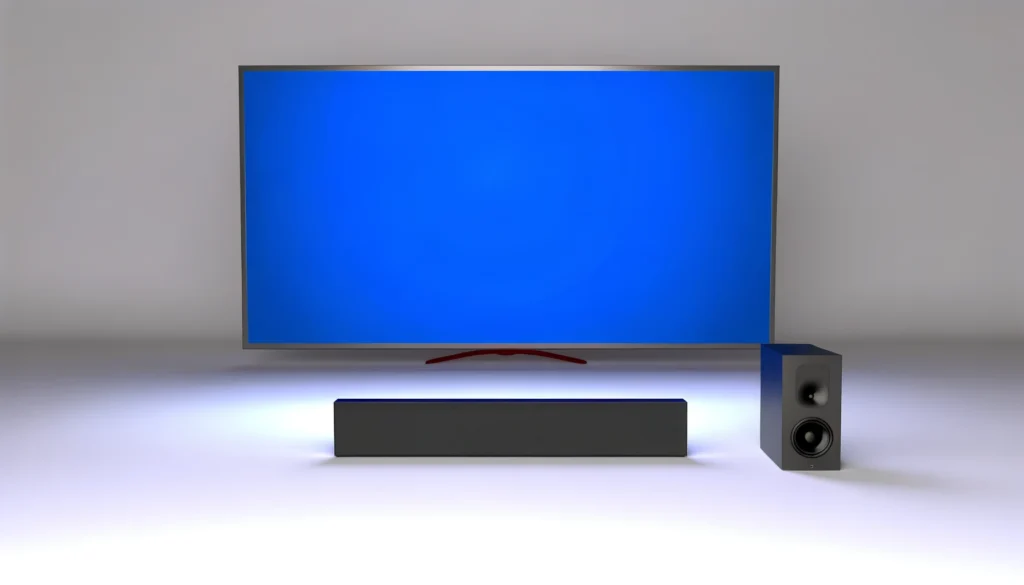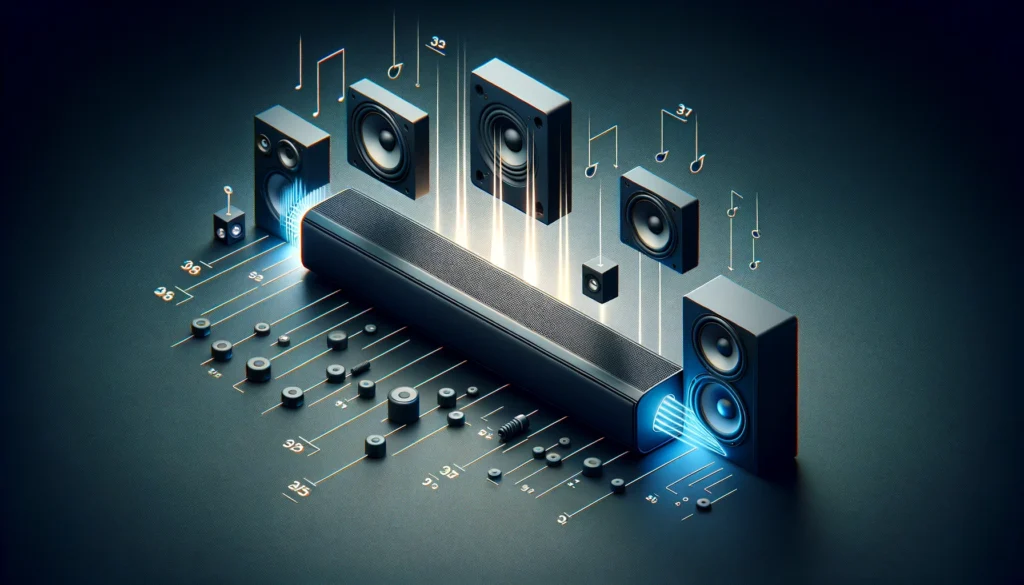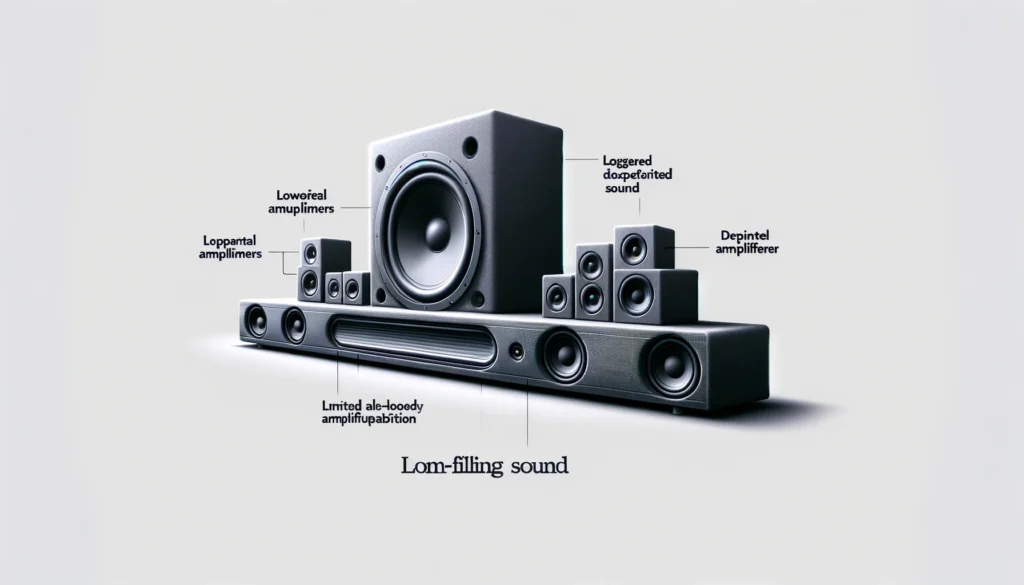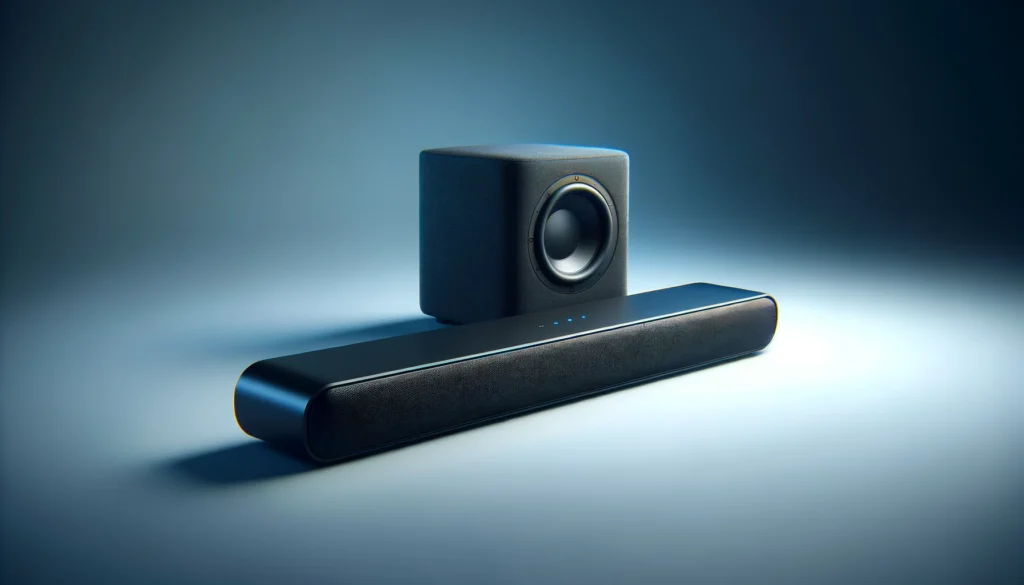Do you ever struggle to hear the dialogue and action during intense movie scenes on your flat-screen TV? The sound seems to get drowned out or distorted when the volume gets turned up.
Thin televisions may offer sleek aesthetics, but they lack the speaker power needed for truly immersive entertainment.
Let’s dive in to learn why adding a soundbar can transform your home theater experience.
Why Flat Screen TVs Urgently Need Soundbars for Immersive Entertainment

Flat screen televisions need a soundbar because their slim built-in speakers fail to deliver the audio quality and volume capacity needed for immersive cinematic or musical enjoyment, especially in larger rooms.
Soundbars provide bigger, better positioned speakers along with more powerful amplification that links clearer audio with on-screen visuals for a complete home theater experience flat screens alone cannot match.
We’ll explore these benefits more in depth ahead.
But first, let’s look closer at the key weaknesses of modern flat panel television speakers and why an external sound system upgrade proves so important.
Flat Screen TVs Have Inferior Built-In Speakers

The thin design of modern flat panel televisions limits the size and sound quality of the built-in speakers.
Internal speakers have to fit inside the narrow frame of the flat screen TV, so they are physically small and lacking in the components that produce rich, full audio.
These compact speakers then have to face backwards or downwards to bounce sound off the wall or table behind the TV stand.
This leads to muffled audio that often gets trapped behind the body of the display.
The small drivers limit the maximum volume level the internal speakers can produce without distortion, resulting in audio that cannot get sufficiently loud in larger rooms.
Overall, flat screen TVs have lower maximum volume and inferior audio quality from their inferior built-in speakers compared to a dedicated soundbar speaker system.
Most flat screen televisions have two stereo speakers built into their slim frame to produce sound.
However, these speakers are tiny compared to those found in older, bulkier CRT tube televisions which had more internal space.
Modern flat screens prioritize sleek industrial design over audio performance, shoehorning tiny mid-range drivers and limited bass response into a narrow body.
The speakers then have to bounce this audio off surfaces behind them since they cannot directly face the viewer.
All of these limitations lead to a muffled, constrained sound.
Soundbars Improve Audio Quality

Soundbars improve upon flat screen audio with their larger, higher quality stereo speaker components.
Being separate from the TV in their own acoustic enclosure means soundbars can pack in bigger drivers, tweeters, and advanced processing powered by hefty built-in amplifiers not found in flat screens.
This leads to better audio range and clarity across voices, music, and major motion picture soundtracks.
Soundbars project sound directly forward rather than bouncing it backwards like a flat screen, leading to clearer audio reaching the listener.
Some premium models even support Dolby Atmos for surrounding 3D object-based sound that flat screens cannot match.
Dedicated soundbars provide full home theater audio immersion that modern slim flat panel televisions lack.
The key advantage of soundbars lies in their bigger speakers with dedicated components for optimized frequency response performance.
Most soundbars have at least two or three front-facing drivers spanning mid-range clarity for vocals alongside deeper bass.
Additional tweeters reproduce higher treble details like cymbals or ambient effects.
This avoids the flat, muddy sound of compact TV speakers trying to cram everything into the same drivers.
Better separation across specialized transducer components gives the overall sound more dimensionality.
Furthermore, advanced soundbars integrate premium touches like Dolby Atmos height channel processing.
This enables a hemispheric 3D soundstage over basic stereo by optimizing audio cues placed at different virtual positions around the room.
Object-based sound design takes full advantage, with effects like helicopters flying overhead or rainfall completely surrounding the viewer.
No television alone can reproduce such immersive 360-degree audio experiences.
Only dedicated soundbars have the hardware and format support necessary.
Soundbars Give You Better Volume Control

Flat screen TVs have limited amplification abilities to drive their small built-in speakers to higher volumes required for larger rooms.
Soundbars contain more powerful external amplifiers that help project louder, room-filling sound optimized across various seating positions and room sizes.
Dedicated amplifiers paired with bigger drivers allow for fuller-bodied audio reproduction at higher decibels without distortion.
Adjustable volume control also aids in compensating for any background noise or other situations where standard TV speaker loudness may not suffice.
Overall, soundbars give users more granular volume adjustment flexibility compared to basic flat screens lacking horsepower.
A flat panel television relies on small integrated amplifiers to raise and lower volume fed into compact internal speakers.
However, affordable amplifiersdesigned to conserve space and cost in mass market displays understandably have limited power.
Television sets largely assume personal viewing distances in modest living rooms, rather than dedicated home theaters designed for entertainment immersion.
Consequently, a flat screen TV often strains to reach volumes suitable for larger spaces or rows of further reclined seating.
Quieter audio reproduction struggles to compete with any ambient noise from air systems, pets, or outdoors compromising clarity.
Even at higher volumes, the underpowered built-in speakers distort from pumping against their shallow acoustic chambers to little effect beyond flat, buzzing sound.
In contrast, soundbars build dedicated amplification tailored towards room-filling surround sound into their chassis separate from the video display.
More powerful multichannel amplifiers have headroom to cleanly boost audio levels across the soundbar’s larger, more capable transducers without bottoming out or distorting.
Users can better calibrate volume for conversational dialog to pierce distractions in one scene, then feel thunderous bass boom through a battle sequence at reference levels the next.
Integrated night or speech modes help tweak amplification matching the content or viewing environment as well.
Altogether, soundbars empower greater volume control flexibility better suiting entertainment spaces than limited television speakers ever could.
Soundbar Position Optimizes Sound

Soundbars optimally position larger speaker components directly under or in front of the video screen to link audio and visual elements in a singular experience.
This allows the sound to radiate unobstructed towards viewers rather than reflecting off surfaces behind flat screen televisions.
Angling speakers on the soundbar platform up towards the central seating position also favors sound clarity over flat screens firing audio downwards.
With their own enclosure, soundbars can shape sound waves free of video display overhang otherwise creating acoustic interference.
Altogether a dedicated low profile sound system achieves better soundwave propagation benefiting audio-visual entertainment compared to compact flat panel televisions.
Ideally, the soundbar speaker unit has a clear line of sight under the video display so audio seems to originate from action on-screen.
This helps fuse together sound effects, soundtrack music, or character voices with the visuals as single theater-like experience.
Flat screens instead require audio to bounce off the wall first before reflecting back towards viewers.
Not only does this introduce phase distortion, but the flat panel body itself can create diffraction as sound wraps around the thin enclosure.
Angled drivers on a soundbar avoid both issues to better tie together sight and sound in harmony.
Furthermore, good soundbars angle speakers upwards to fire towards the central seating position rather than down at the ground.
This intentional directivity through advanced waveguide designs minimizes audio damping across the floor to maintain clarity.
It also means viewers are within the optimized listening window.
Flat screens often have drivers facing down to reflect sound, which overemphasizes certain frequencies as audio scatters in all directions.
A dedicated sound system like a soundbar has more control shaping soundwaves precisely towards the audience.
Adding a Subwoofer Takes It a Step Further

For listeners demanding truly impactful audio immersion, soundbars offer wireless subwoofer pairing to fill in the lowest bass frequencies the main unit cannot reproduce.
These compact cube subwoofers integrate larger drivers and amplification dedicated solely to deep bass sound effects like explosions or electronic music that flat television speakers cannot hope to match.
They integrate wirelessly with the soundbar while locating the subwoofer separately to avoid muffling bass vibrations within the same enclosure.
When properly balanced and positioned to eliminate phase cancellation, adding a wireless active subwoofer completes the cinematic audio experience flat screens lack.
While premium soundbars can reach down to 80 or 100hz enough for strong musical basslines or punchy gunshots, the lowest rumbles like spacecraft engines or synth drops require a dedicated extended range subwoofer.
These cube enclosures hide huge 6” to 10” inverted drivers powered by robust internal amps tuned specifically for loud, low bass absent in compact flat televisions.
Positioning the subwoofer along the floor or corner loaded also takes advantage of boundary gain reinforcing ultra-low 20-80hz notes that even bookshelf speakers struggle to achieve.
The result is three dimensional, palpable bass energy connecting viewers to intense movie action or concert music better than any flat screen alone.
To integrate the standalone subwoofer component while keeping soundbar installation simple, wireless amp/driver pairing allows flexible placement not possible with wired alternatives.
Subwoofers utilize integrated transmitters in unison with wireless receivers built into the soundbar to synchronize ultra low-frequency effects absent phase differential or listening fatigue from audio delays.
This gives listeners precision cinematic sound with the convenience of a single cable HDMI connection from screen to sound system controlling everything.
Hobbyists can still further tweak subwoofer crossover, volume and parametric EQ settings for room needs.
Altogether, the addition of a compact yet capable wireless active subwoofer paired to a full-range soundbar delivers audio performance enhancing film and music well beyond built-in flat panel TV speakers.
Conclusion
In conclusion, the limited physical space and amplification of flat screen TV speakers lead to inferior audio quality that detracts from the entertainment experience.
Investing in a dedicated soundbar system with better drivers, tuning, and wireless subwoofer pairing gives your movies, music, and more the engrossing surround sound they deserve.
